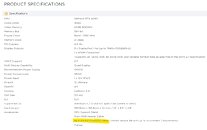- Joined
- Oct 9, 2007
- Messages
- 47,427 (7.51/day)
- Location
- Hyderabad, India
| System Name | RBMK-1000 |
|---|---|
| Processor | AMD Ryzen 7 5700G |
| Motherboard | ASUS ROG Strix B450-E Gaming |
| Cooling | DeepCool Gammax L240 V2 |
| Memory | 2x 8GB G.Skill Sniper X |
| Video Card(s) | Palit GeForce RTX 2080 SUPER GameRock |
| Storage | Western Digital Black NVMe 512GB |
| Display(s) | BenQ 1440p 60 Hz 27-inch |
| Case | Corsair Carbide 100R |
| Audio Device(s) | ASUS SupremeFX S1220A |
| Power Supply | Cooler Master MWE Gold 650W |
| Mouse | ASUS ROG Strix Impact |
| Keyboard | Gamdias Hermes E2 |
| Software | Windows 11 Pro |
PSUs with native 12+4 pin ATX 12VHPWR connectors are few and far between, which means some of the first adopters of the GeForce RTX 4090 "Ada" graphics cards will rely on the adapter cable that converts 8-pin PCIe power connectors into one 12VHPWR connector that plugs into the graphics card. Cards that stick to the baseline specs include adapters that convert three 8-pin PCIe connectors (for 450 W output that matches the RTX 4090 reference specs); whereas some premium overclocked RTX 4090 cards, such as the ZOTAC RTX 4090 AMP Extreme, include adapters that convert as many as four 8-pin PCIe to a 12VHPWR, maxing out its 600 W power delivery capability. The product page of the ZOTAC AMP Extreme has an interesting sentence describing this in-box adapter: "Limited service life with up to 30 connect / disconnects."
Apparently the adapter is only good for up to 30 connect/disconnect cycles safely, before you'll need another one. For most gamers who'll install the card and forget about it for years, this shouldn't be an issue. However, for overclockers and enthusiasts using the card on an open-air bench and who rely on a lot of moving cards around, this could be an irritant. Tech journalists (reviewers) swap graphics cards out a lot, too, but then they're likely to have several such adapters lying around from multiple samples, or a PSU with a native 12+4 pin connector.


Our best guess is that this is a mechanical limitation assessed by NVIDIA for the maximum number of times the adapter can handle connection cycles before its contacts begin to wear out, and its safety is compromised. If you look closely at the picture above, the adapter has an NVIDIA logo, which means NVIDIA is directly supplying this adapter to AIC partners to include with their custom-design cards (and not counting on them to develop their own adapters). The 12VHPWR connector may look diminutive, but it's capable of delivering not just 600 W continuously, but also handle 200% excursions (brief spikes in power draw), which mean 1200 W. This is a lot of current (12 V, 100 A, enough to crank an automobile), and so NVIDIA isn't taking any chances with safety.
View at TechPowerUp Main Site | Source
Apparently the adapter is only good for up to 30 connect/disconnect cycles safely, before you'll need another one. For most gamers who'll install the card and forget about it for years, this shouldn't be an issue. However, for overclockers and enthusiasts using the card on an open-air bench and who rely on a lot of moving cards around, this could be an irritant. Tech journalists (reviewers) swap graphics cards out a lot, too, but then they're likely to have several such adapters lying around from multiple samples, or a PSU with a native 12+4 pin connector.


Our best guess is that this is a mechanical limitation assessed by NVIDIA for the maximum number of times the adapter can handle connection cycles before its contacts begin to wear out, and its safety is compromised. If you look closely at the picture above, the adapter has an NVIDIA logo, which means NVIDIA is directly supplying this adapter to AIC partners to include with their custom-design cards (and not counting on them to develop their own adapters). The 12VHPWR connector may look diminutive, but it's capable of delivering not just 600 W continuously, but also handle 200% excursions (brief spikes in power draw), which mean 1200 W. This is a lot of current (12 V, 100 A, enough to crank an automobile), and so NVIDIA isn't taking any chances with safety.
View at TechPowerUp Main Site | Source






 , ridiculous ..
, ridiculous ..